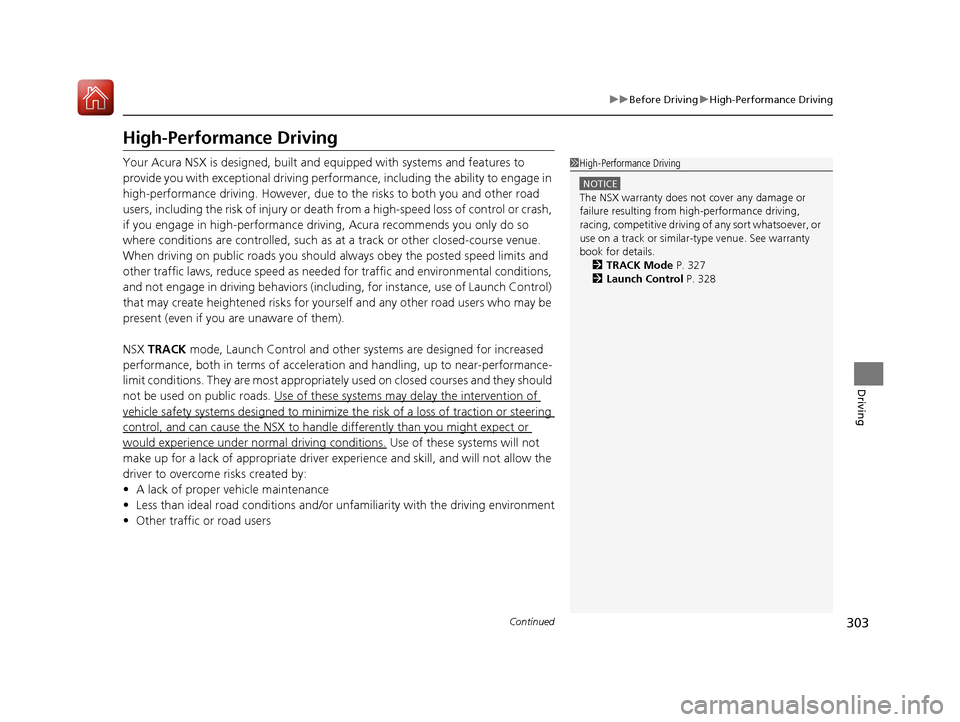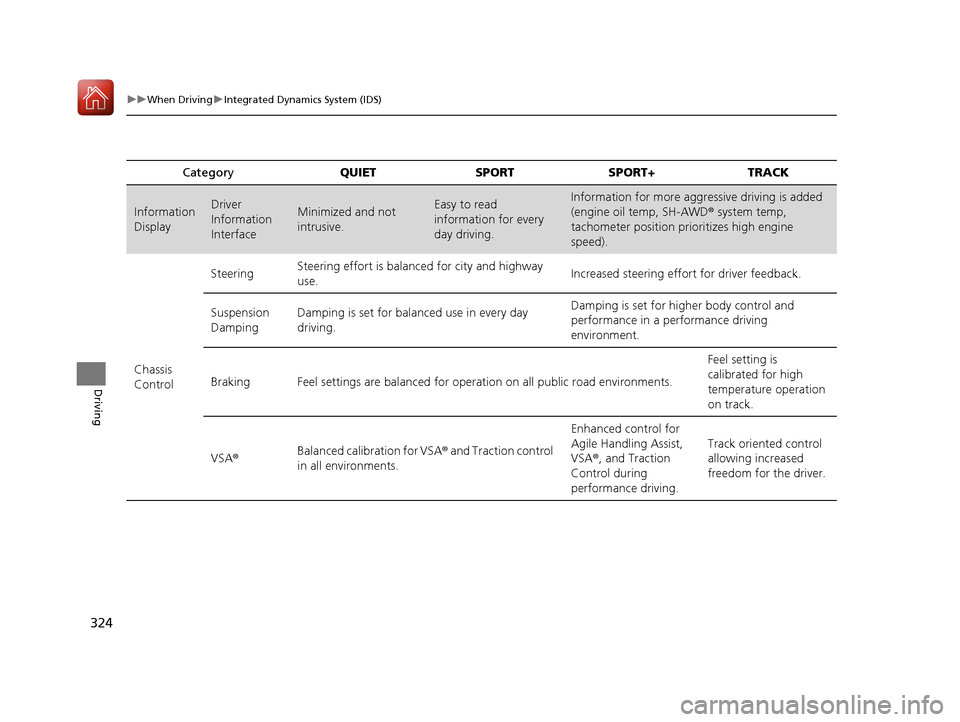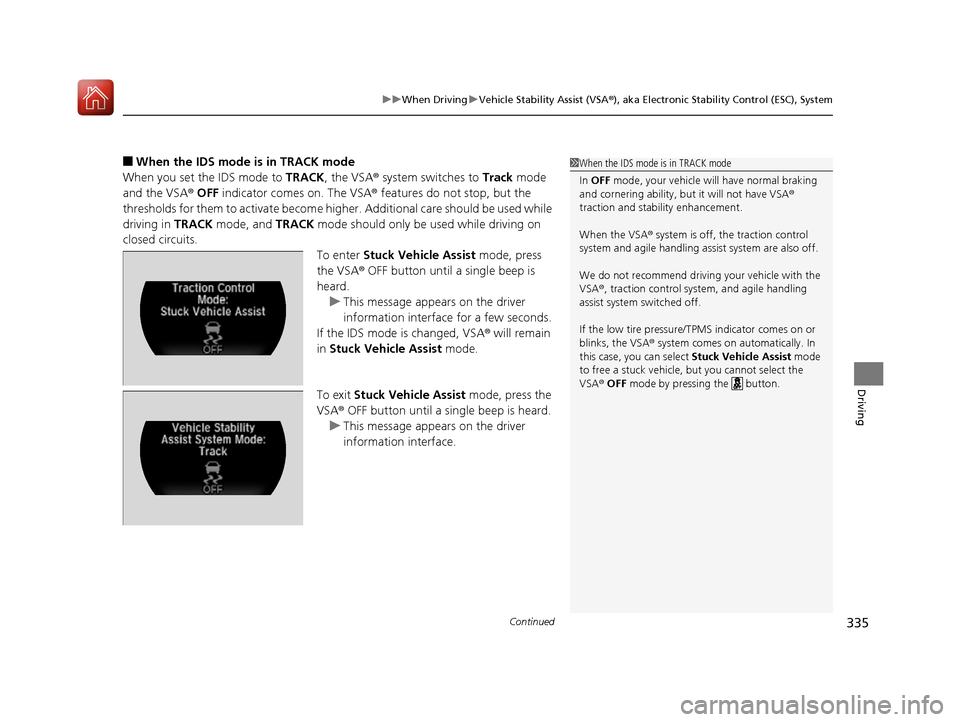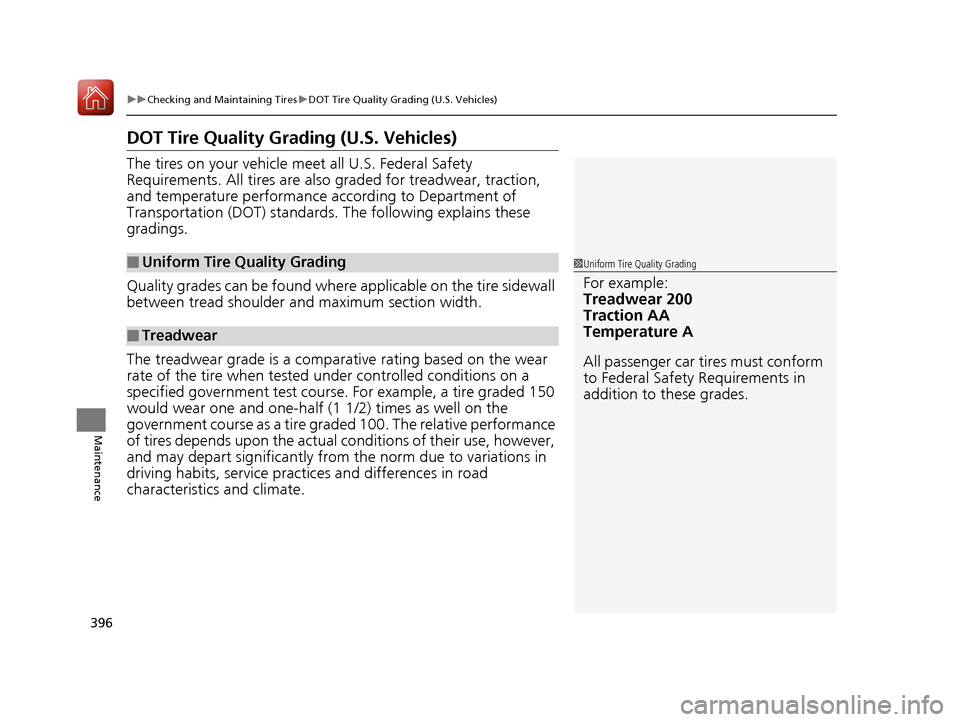traction control Acura NSX 2017 Owner's Manual
[x] Cancel search | Manufacturer: ACURA, Model Year: 2017, Model line: NSX, Model: Acura NSX 2017Pages: 473, PDF Size: 16.01 MB
Page 304 of 473

303
uuBefore Driving uHigh-Performance Driving
Continued
Driving
High-Performance Driving
Your Acura NSX is designed, built and equipped with systems and features to
provide you with exceptional driving performa nce, including the ability to engage in
high-performance driving. Ho wever, due to the risks to both you and other road
users, including the risk of injury or death from a high-speed loss of control or crash,
if you engage in high-performance driving, Acura recommends you only do so
where conditions are controlled, such as at a track or other closed-course venue.
When driving on public roads you should always obey the posted speed limits and
other traffic laws, reduce speed as needed for traffic and environmental conditions,
and not engage in driving behaviors (includi ng, for instance, use of Launch Control)
that may create heightened risks for your self and any other road users who may be
present (even if you are unaware of them).
NSX TRACK mode, Launch Control and other systems are designed for increased
performance, both in terms of accelerati on and handling, up to near-performance-
limit conditions. They are most appropriately used on closed courses and they should
not be used on public roads. Use of these systems may delay the intervention of
vehicle safety systems designed to minimize the risk of a loss of traction or steering
control, and can cause the NSX to handle differently than you might expect or
would experience under normal driving conditions. Use of these systems will not
make up for a lack of appropriate driver experience and skill, and will not allow the
driver to overcome risks created by:
• A lack of proper vehicle maintenance
• Less than ideal road conditions and/or unfamiliarity with the driving environment
• Other traffic or road users
1High-Performance Driving
NOTICE
The NSX warranty does not cover any damage or
failure resulting from hi gh-performance driving,
racing, competitive driving of any sort whatsoever, or
use on a track or similar-type venue. See warranty
book for details. 2 TRACK Mode P. 327
2 Launch Control P. 328
17 NSX-31T6N6000.book 303 ページ 2016年4月22日 金曜日 午後3時44分
Page 325 of 473

324
uuWhen Driving uIntegrated Dynamics System (IDS)
Driving
Category QUIET SPORT SPORT+ TRACK
Information
DisplayDriver
Information
InterfaceMinimized and not
intrusive.Easy to read
information for every
day driving.Information for more aggressive driving is added
(engine oil temp, SH-AWD ® system temp,
tachometer position pr ioritizes high engine
speed).
Chassis
Control Steering
Steering effort is balanced for city and highway
use. Increased steering effort for driver feedback.
Suspension
Damping Damping is set for balanced use in every day
driving. Damping is set for higher body control and
performance in a performance driving
environment.
Braking Feel settings are balanced for oper ation on all public road environments.Feel setting is
calibrated for high
temperature operation
on track.
VSA ® Balanced calibration for VSA
® and Traction control
in all environments. Enhanced control for
Agile Handling Assist,
VSA
®, and Traction
Control during
performance driving. Track oriented control
allowing increased
freedom for the driver.
17 NSX-31T6N6000.book 324 ページ 2016年4月22日 金曜日 午後3時44分
Page 326 of 473

325
uuWhen Driving uIntegrated Dynamics System (IDS)
Continued
Driving
Category QUIET SPORT SPORT+ TRACK
Powertrain
Control
Powertrain
Start-upEV operation is
prioritized, starts
quietly.Powerful start-up sound.
Powertrain
SoundMinimum sound for
quiet driving.Balanced sound for city
and highway use.Emotional sound for
increased feedback.Maximum sound for
driving on race track
with helmet on.
Hybrid
Battery
ManagementEfficiency and smooth
quiet operation are
prioritized.Balanced management
for response and
efficiency.Maximum electric assist
for acceleration.Battery charge is
managed to give
consistent lap time
during track use.
Hybrid
Battery A/C
CoolingBattery A/C cooling is
not used in this mode.Battery A/C cooling is active however cabin
cooling is prioritized.Battery A/C cooling is
active and may
compromise cabin
cooling.
EV OperationAvailableAvailableNot availableNot available
Driving Force
CharacterEase of force
modulation for
comfortable operation.Balanced tuning of
drive force request for
all driving scenarios.Maximum response.Linear response for
ease of cornering line
control.
DCT Shift
Map/
ResponseComfortable/low
engine speed priority.Balanced tuning for all
driving scenarios.Quick downshifts on
request, lower gears
are held for maximum
response.Gears are held to
maximize performance
on track. Shifts are very
fast.
SH-AWD®Quiet and comfortable
operation.Balanced setting for
secure every day use in
any condition.Traction and response
are prioritized for
performance on
winding roads.Settings are optimized
for dry surface, high
cornering load with
neutral handling
attitude.
17 NSX-31T6N6000.book 325 ページ 2016年4月22日 金曜日 午後3時44分
Page 334 of 473

333
uuWhen Driving uVehicle Stability Assist (VSA ®), aka Electronic Stability Control (ESC), System
Continued
Driving
Vehicle Stability Assist (VSA ®), aka Electronic
Stability Control (ESC), System
Helps to stabilize the vehicl e during cornering if the vehicle turns more or less than
what was intended. It also assists in main taining traction on slippery surfaces. It does
so by regulating engine and motor output and selectively applying the brakes.
When VSA® activates, you may notice that the
engine and motor do not respond to the
accelerator. You may also notice some noise
from the hydraulic system. You will also see
the indicator blink.
■VSA ® Operation
1 Vehicle Stability Assist (VSA ®), aka Electronic Stability Control
(ESC), System
VSA ® may not function properly if tire type and size
are mixed. Make sure to use the same size and type
of tire, and the air pr essures as specified.
2 Tire and Wheel Replacement P. 399
When the VSA ® system indicator comes on and stays
on while driving, there ma y be a problem with the
system. While this may not interfere with normal
driving, have your vehicle checked by an authorized
Acura NSX dealer immediately.
VSA ® cannot enhance stability in all driving situations
and does not control the entire braking system. You
still need to drive and corner at speeds appropriate
for the conditions and always leave a sufficient
margin of safety.
The main function of the VSA ® system is generally
known as Electronic Stability Control (ESC). The
system also includes a traction control function.
VSA® System
Indicator
17 NSX-31T6N6000.book 333 ページ 2016年4月22日 金曜日 午後3時44分
Page 335 of 473

uuWhen Driving uVehicle Stability Assist (VSA® ), aka Electronic Stability Control (ESC), System
334
Driving
This button is on the driver side control panel.
This button is used to change VSA ® modes.
See below for more information.
VSA ® is turned on every time you turn the
power system on, even if you press the button
the last time you drove the vehicle.
■When the IDS mode is in QUIET mode, SPORT mode, or SPORT+ mode
To enter Stuck Vehicle Assist mode, press
the VSA® OFF button until a single beep is
heard and the VSA ® OFF indicator illuminates.
u This message appears on the driver
information interface for a few seconds.
If the IDS mode is changed, VSA ® will remain
in Stuck Vehicle Assist mode.
To exit Stuck Vehicle Assist mode, press the
VSA ® OFF button until a single beep is heard
and the VSA ® OFF indicator extinguishes.
■VSA ® OFF Button1 Vehicle Stability Assist (VSA ®), aka Electronic Stability Control
(ESC), System
In Stuck Vehicle Assist mode, your vehicle will have
normal braking and corn ering ability, but VSA®
traction and stability enhancement becomes less
effective.
In certain unusual conditions when your vehicle gets
stuck in shallow mud or fr esh snow, it may be easier
to free it with Stuck Vehicle Assist mode.
In Stuck Vehicle Assist mode, the traction control
function becomes less effective. This allows for the
wheels to spin more freely at low speed. You should
only attempt to free your vehicle with the button
pressed if you are not able to free it without.
Immediately after freeing your vehicle, be sure to
press the button again. We do not recommend
driving your vehicle with Stuck Vehicle Assist mode.
You may hear a motor sound coming from the front
of the vehicle while system checks are being
performed immediately after turning the power
system on or while driving. This is normal.
VSA ® OFF Indicator
17 NSX-31T6N6000.book 334 ページ 2016年4月22日 金曜日 午後3時44分
Page 336 of 473

Continued335
uuWhen Driving uVehicle Stability Assist (VSA ®), aka Electronic Stability Control (ESC), System
Driving
■When the IDS mode is in TRACK mode
When you set the IDS mode to TRACK, the VSA ® system switches to Track mode
and the VSA ® OFF indicator comes on. The VSA ® features do not stop, but the
thresholds for them to activate become hi gher. Additional care should be used while
driving in TRACK mode, and TRACK mode should only be used while driving on
closed circuits.
To enter Stuck Vehicle Assist mode, press
the VSA® OFF button until a single beep is
heard.
u This message appears on the driver
information interface for a few seconds.
If the IDS mode is changed, VSA ® will remain
in Stuck Vehicle Assist mode.
To exit Stuck Vehicle Assist mode, press the
VSA ® OFF button until a single beep is heard.
u This message appears on the driver
information interface.1When the IDS mode is in TRACK mode
In OFF mode, your vehicle wi ll have normal braking
and cornering ability, bu t it will not have VSA®
traction and stability enhancement.
When the VSA ® system is off, the traction control
system and agile handling assist system are also off.
We do not recommend driving your vehicle with the
VSA ®, traction control syst em, and agile handling
assist system switched off.
If the low tire pressure/TPMS indicator comes on or
blinks, the VSA® system comes on automatically. In
this case, you can select Stuck Vehicle Assist mode
to free a stuck vehicle, but you cannot select the
VSA ® OFF mode by pressing the button.
17 NSX-31T6N6000.book 335 ページ 2016年4月22日 金曜日 午後3時44分
Page 397 of 473

396
uuChecking and Maintaining Tires uDOT Tire Quality Grading (U.S. Vehicles)
Maintenance
DOT Tire Quality Grading (U.S. Vehicles)
The tires on your vehicle meet all U.S. Federal Safety
Requirements. All tires are also graded for treadwear, traction,
and temperature performance a ccording to Department of
Transportation (DOT) standards. The following explains these
gradings.
Quality grades can be found where applicable on the tire sidewall
between tread shoulder an d maximum section width.
The treadwear grade is a comparative rating based on the wear
rate of the tire when tested un der controlled conditions on a
specified government test course. For example, a tire graded 150
would wear one and one-half (1 1/2) times as well on the
government course as a tire graded 100. The relative performance
of tires depends upon the actual conditions of their use, however,
and may depart significantly from the norm due to variations in
driving habits, service practices and differences in road
characteristics and climate.
■Uniform Tire Quality Grading
■Treadwear
1 Uniform Tire Quality Grading
For example:
Treadwear 200
Traction AA
Temperature A
All passenger car tires must conform
to Federal Safety Requirements in
addition to these grades.
17 NSX-31T6N6000.book 396 ページ 2016年4月22日 金曜日 午後3時44分
Page 398 of 473

397
uuChecking and Maintaining Tires uDOT Tire Quality Grading (U.S. Vehicles)
Maintenance
The traction grades, from highest to lowest, are AA, A, B, and C.
Those grades represent the tire’s ability to stop on wet pavement
as measured under controlled conditions on specified
government test surfaces of asph alt and concrete. A tire marked
C may have poor traction performance.
The temperature grades are A (the highest), B, and C,
representing the tire’s resistance to the generation of heat and its
ability to dissipate heat when te sted under controlled conditions
on a specified indoor laboratory test wheel. Sustained high
temperature can cause the material of the tire to degenerate and
reduce tire life, and ex cessive temperature can lead to sudden tire
failure. The grade C corresponds to a level of performance which
all passenger car tires must meet under the Federal Motor Vehicle
Safety Standard No. 109. Grades B and A represent higher levels
of performance on the laboratory test wheel than the minimum
required by law.
■Traction
■Temperature
1 Traction
Warning: The traction grade
assigned to this tire is based on
straight-ahead braking traction tests,
and does not include acceleration,
cornering, hydroplaning, or peak
traction characteristics.
1Temperature
Warning: The temperature grade for
this tire is establishe d for a tire that is
properly inflated and not
overloaded. Excessive speed,
underinflation, or excessive loading,
either separately or in combination,
can cause heat buildup and possible
tire failure.
17 NSX-31T6N6000.book 397 ページ 2016年4月22日 金曜日 午後3時44分